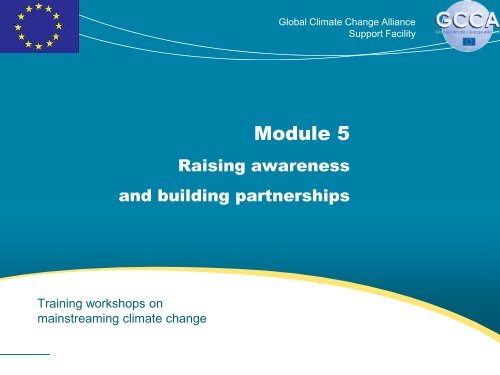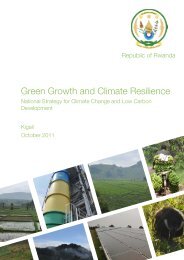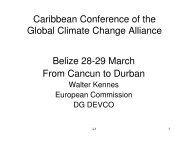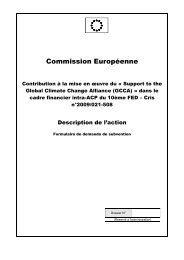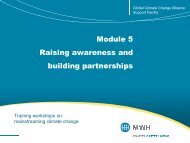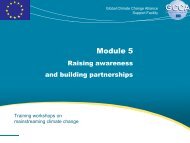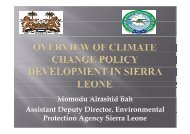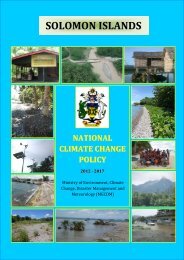Adaptation - Global Climate Change Alliance
Adaptation - Global Climate Change Alliance
Adaptation - Global Climate Change Alliance
Create successful ePaper yourself
Turn your PDF publications into a flip-book with our unique Google optimized e-Paper software.
<strong>Global</strong> <strong>Climate</strong> <strong>Change</strong> <strong>Alliance</strong><br />
Support Facility<br />
Module 5<br />
Raising awareness<br />
and building partnerships<br />
Training workshops on<br />
mainstreaming climate change
Tools supporting awareness raising<br />
and partnership building<br />
Assessing<br />
evidence<br />
Engaging key<br />
actors<br />
Vulnerability and<br />
adaptation<br />
assessments<br />
Macro and meso<br />
economic<br />
analysis<br />
Demonstration or<br />
pilot projects<br />
Communication<br />
& advocacy<br />
strategy<br />
Awareness<br />
raising &<br />
partnership<br />
building<br />
National<br />
consensus on<br />
and commitment<br />
to climateresilient<br />
and lowemission<br />
development<br />
Adapted from: UNDP-UNEP (2011)<br />
2
Vulnerability and adaptation<br />
assessment<br />
• A vulnerability and adaptation assessment<br />
would typically focus on 3 units of analysis:<br />
– Places: land, water, ecosystems, ‘natural capital’ and<br />
‘built infrastructure’<br />
– People: individuals, communities, ‘human capital’,<br />
livelihoods<br />
– Institutions: sectors, organisations, how they relate to<br />
each other, ‘social capital’<br />
• It should assess both current & future vulnerability<br />
to determine possible adaptation measures<br />
Source: Downing & Patwardhan (2004)<br />
3
Steps in community vulnerability &<br />
adaptation assessment<br />
4<br />
Source: IPCC (2007c)<br />
4 th Assessment Report,<br />
WG II - Fig. 16.3
Mapping vulnerability<br />
Exhibit 3 – Highly granular geographic information has been used to<br />
segment assets according to their elevation above sea level<br />
Elevation map of central Apia<br />
Elevation<br />
Approach<br />
• Starting point was a<br />
digital map of<br />
Samoa with contour<br />
lines (2m lines in<br />
coastal areas)<br />
• In a second step, a<br />
more granular<br />
segmentation of<br />
coastal areas was<br />
obtained by using<br />
state-of-the-art GIS<br />
software<br />
• Finally, geocoordinates<br />
of<br />
buildings and roads,<br />
were used to<br />
determine the asset<br />
exposure to coastal<br />
flooding risk<br />
0 m<br />
1 m<br />
2 m<br />
>4 m<br />
Building<br />
Road<br />
SOURCE: Team analysis<br />
Source: Economics of <strong>Climate</strong> <strong>Adaptation</strong> (2009) Test case on Samoa – Focus on<br />
risks caused by sea level rise, Fig. 03, p. 122<br />
5
Macro- and meso-economic<br />
analysis<br />
• Economic analysis may be a powerful tool for<br />
motivating policy makers to take action<br />
– Macro level: analysis of the impact climate change may<br />
have on the national economy<br />
– Meso level: analysis at the level of key sectors or subsectors<br />
of the national economy<br />
• The costs of inaction (climate-related losses) are<br />
compared with the net benefits of taking action (costs<br />
minus avoided losses)<br />
• The analysis should also consider the distribution of<br />
losses and benefits (among social groups, regions...)<br />
6
Vulnerability assessment with an<br />
economic focus: Mozambique<br />
7<br />
• Hazard assessment: evaluate<br />
location, severity, probable frequency<br />
of hazardous events<br />
• Assessment of direct loss potential:<br />
analyze/quantify impact of historical<br />
and probable future drought/flood<br />
events<br />
• Evaluation of adaptation scenarios:<br />
identify/formulate options to reduce<br />
drought- and flood-related risk and<br />
economic vulnerability<br />
Source: WB-RMSI-IFPRI-GFDRR (2007) Figure 9 (a), p. 19
Mozambique economic vulnerability<br />
assessment: methods<br />
• Assessment of direct economic loss potential<br />
from droughts/floods<br />
– Macro level and main economic sectors<br />
• Assessment of indirect economic loss potential<br />
– Macro level, based on interdependencies between sectors<br />
• Assessment of total loss potentials across sectors and<br />
geographical areas / administrative zones<br />
• Assessment of economic impact (in terms of avoided<br />
losses) of adaptation (‘risk mitigation’) options<br />
– Macro level and main economic sectors<br />
8
Tanzania: Expected losses across scenarios<br />
due to lower availability of electricity<br />
Annualexpectedloss in 2008 and 2030<br />
$m,2008dollars<br />
Cost of power cuts on<br />
GDP<br />
Cost of using individual<br />
generators<br />
Additional cost of<br />
power production<br />
14<br />
64<br />
55<br />
5<br />
4<br />
571<br />
141<br />
100<br />
330<br />
1320<br />
470<br />
350<br />
500<br />
2008: Today’s<br />
expected loss<br />
2030: Today’s<br />
climate<br />
2030: Moderate<br />
climate change<br />
2030: High<br />
climate change<br />
Percent loss in<br />
national GDP<br />
0.01<br />
0.09<br />
0.7<br />
1.7<br />
Without climate change, the available electricity would be sufficient to avoid GDP losses<br />
However, decreased rainfall in both climate change scenarios will lead to losses in GDP of up to 1.7%<br />
1 Current dollars<br />
2 60% of entities have their own generator<br />
Source: Economics of <strong>Climate</strong> <strong>Adaptation</strong> (2009) – Case study on central Tanzania – Figure 05, p. 129<br />
9<br />
•
Demonstration projects<br />
Test what<br />
works and<br />
does not work<br />
(relevance,<br />
effectiveness)<br />
Support<br />
lesson<br />
drawing for<br />
adaptive<br />
management<br />
Demonstration/<br />
pilot projects<br />
Mobilise<br />
communities,<br />
local/regional<br />
authorities & other<br />
stakeholders<br />
Help foster<br />
interest and<br />
commitment<br />
of national<br />
authorities &<br />
other<br />
stakeholders<br />
Create motivation<br />
and knowledge<br />
for replication/<br />
scaling-up<br />
Source: UNDP-UNEP (2011)<br />
10
Raising awareness and building<br />
partnerships (1)<br />
11<br />
• Assessing available evidence:<br />
– using the findings of relevant studies and<br />
demonstration/pilot projects<br />
• Engaging key actors:<br />
– identifying and mobilising key organisations involved in<br />
development at the national and sector levels<br />
– identifying and mobilising ‘champions’<br />
Who might be good<br />
champions<br />
Are there already<br />
champions
Raising awareness and building<br />
partnerships (2)<br />
• Developing and implementing a communication<br />
and advocacy strategy in support of mainstreaming:<br />
– Define the target audience to be informed or influenced<br />
– Develop policy-relevant messages and materials based on<br />
evidence collected (e.g. policy briefs, radio programmes)<br />
– Select and use appropriate communication channels for<br />
the various target groups (e.g. media, sector working<br />
groups)<br />
12
Discussion and action planning<br />
13
Turning words into action<br />
• Understanding climate change science<br />
• Understanding and planning under uncertainty<br />
• Raising awareness and building partnerships<br />
What can be done and what are<br />
the institutional and capacity<br />
needs in your organisation<br />
14
15<br />
References (1)<br />
• Downing T. & Patwardhan A. (2004) Assessing Vulnerability for <strong>Climate</strong> <strong>Adaptation</strong>. In: Lim B. &<br />
Spanger-Siegfried E. (eds.) (2004) <strong>Adaptation</strong> Policy Frameworks for <strong>Climate</strong> <strong>Change</strong>:<br />
Developing Strategies, Policies and Measures. United Nations Development<br />
Programme/Cambridge University Press, New York. Available from:<br />
http://www.undp.org/climatechange/adapt/apf.html<br />
• Economics of <strong>Climate</strong> <strong>Adaptation</strong> Working Group (2009) Shaping climate-resilient development: a<br />
framework for decision-making. <strong>Climate</strong> Works Foundation, <strong>Global</strong> Environment Facility,<br />
European Commission, McKinsey & Company, The Rockfeller Foundation, Standard Chartered<br />
Bank & Swiss Re. Available from:<br />
http://www.mckinsey.com/clientservice/Social_Sector/our_practices/Economic_Development/Kno<br />
wledge_Highlights/Economics_of_climate_adaptation.aspx<br />
• IPCC (2007c) <strong>Climate</strong> <strong>Change</strong> 2007: Impacts, <strong>Adaptation</strong> and Vulnerability. Contribution of<br />
Working Group II to the Fourth Assessment Report of the Intergovernmental Panel on <strong>Climate</strong><br />
<strong>Change</strong> [Parry M.L., Canziani O.F., Palutikof J.P., van der Linden P.J. & Hanson C.E. (eds.)].<br />
Cambridge University Press, Cambridge, UK & New York, NY, USA. Available from: www.ipcc.ch<br />
• UNDP-UNEP (2011) Mainstreaming <strong>Adaptation</strong> to <strong>Climate</strong> <strong>Change</strong> into Development Planning: A<br />
Guide for Practitioners. UNDP-UNEP Poverty-Environment Initiative. Available from:<br />
http://www.unpei.org/knowledge-resources/publications.html
16<br />
References (2)<br />
• WB-RMSI-IFPRI-GFDRR (2009) Economic Vulnerability and Disaster Risk Assessment in Malawi<br />
and Mozambique: Measuring Economic Risks of Droughts and Floods. World Bank, Washington,<br />
DC / RMSI, Noida, India / International Food Policy Research Institute, Washington, DC / <strong>Global</strong><br />
Facility for Disaster Risk Reduction and Recovery. Available from:<br />
http://gfdrr.org/gfdrr/sites/gfdrr.org/files/publication/GFDRR_Econ._Vulnerability_DRR_Malawi-<br />
Mozambique.pdf
<strong>Global</strong> <strong>Climate</strong> <strong>Change</strong> <strong>Alliance</strong><br />
Support Facility<br />
Module 6<br />
Mainstreaming climate change in<br />
national, sector and sub-national<br />
policies, strategies and programmes<br />
Training workshops on<br />
mainstreaming climate change
2<br />
Why mainstream climate change at the national,<br />
sector and sub-national levels
Why mainstream climate change<br />
at strategic planning levels<br />
3<br />
National level<br />
More:<br />
-integrated<br />
-effective<br />
-efficient<br />
-sustainable<br />
responses<br />
Sector<br />
coordination<br />
Allocation of<br />
resources<br />
across sectors<br />
Sector 1<br />
Sector 2<br />
Sector 3<br />
Biophysical<br />
impacts<br />
Socioeconomic<br />
impacts
Why mainstream climate change<br />
at strategic planning levels<br />
National level<br />
Overall guiding policy framework<br />
National legislation/regulation<br />
Exercise of some key functions<br />
Management of international<br />
relations<br />
Sector level<br />
Operationalisation and<br />
implementation of national policies<br />
Sector-specific<br />
legislation/regulation<br />
Wider pool of resources<br />
Wider ownership of response<br />
Own initiatives, development of<br />
capacities & good practices<br />
Transboundary cooperation on<br />
climate-relevant issues<br />
More widespread capacity and institution building<br />
Source: OECD (2009a)<br />
4
Why mainstream climate change at<br />
lower levels of governance<br />
Best levels for<br />
observing /<br />
understanding<br />
development<br />
and climate<br />
change impacts<br />
Sub-national<br />
and local levels<br />
Vulnerability<br />
and adaptive<br />
capacity are<br />
context-specific<br />
Most adaptation<br />
options require<br />
local<br />
implementation<br />
Potential for<br />
piloting /<br />
pioneering<br />
initiatives<br />
Source: OECD (2009a)<br />
5
Key stakeholders and cross-level interactions<br />
6
7<br />
Key stakeholders<br />
Ministries of<br />
Finance,<br />
Ministries with<br />
Planning,<br />
sector-specific<br />
Development<br />
competences<br />
Donor<br />
agencies<br />
Members of<br />
Parliament<br />
Sector<br />
management<br />
agencies<br />
Civil society<br />
organisations<br />
Sub-national /<br />
local governments<br />
Research<br />
organisations<br />
Private<br />
sector<br />
Local<br />
private<br />
sector<br />
Local citizens<br />
& organisations
Top-down and bottom-up<br />
approaches to adaptation<br />
8<br />
National<br />
policies &<br />
strategies<br />
National level<br />
incl. sectors<br />
Focused on<br />
physical<br />
impacts and<br />
‘biophysical<br />
vulnerability’<br />
Freely adapted from Dessai<br />
& Hulme (2004)<br />
Top-down<br />
<strong>Adaptation</strong><br />
Subnational<br />
levels (local in<br />
particular)<br />
Bottom-up<br />
Stakeholder<br />
approach<br />
Focused on<br />
prevailing<br />
socio-economic<br />
& environmental<br />
conditions and<br />
on ‘social<br />
vulnerability’<br />
Model- and<br />
scenario-<br />
driven<br />
Communitybased<br />
adaptation,<br />
pilot projects
9<br />
Main entry points for mainstreaming climate change<br />
in strategic policy and planning processes
Main entry points in the<br />
national and sector policy cycles<br />
Recognise<br />
climate risks<br />
Policy cycle<br />
stage<br />
Policy formulation<br />
Allocate funding for<br />
climate-specific<br />
actions<br />
National level<br />
National long-term vision<br />
National policies and<br />
strategies<br />
Sector level<br />
Sector policies and<br />
strategies<br />
Planning Multi-year development plan Sectoral plans<br />
Resource<br />
allocation<br />
Programming &<br />
implementation<br />
National budget<br />
<strong>Climate</strong>-related fund(s)<br />
Sector-level development<br />
plans and budgets<br />
Sector budget envelopes<br />
Resources from fund(s)<br />
Sector programming<br />
Include<br />
climate<br />
considera<br />
-tions in<br />
project<br />
selection<br />
criteria<br />
Include climaterelated<br />
programmes/<br />
projects (sectoral<br />
and cross-sectoral)<br />
Relocate funding to<br />
vulnerable or priority<br />
sectors/ regions<br />
Incorporate<br />
climate-related<br />
activities<br />
Adapted from: Olhoff & Schaer (2010) Fig. 1, p. 10<br />
10
Illustration: <strong>Climate</strong> change<br />
integration in the forestry sector (1)<br />
11<br />
Objectives:<br />
• Raise awareness and<br />
exchange views<br />
• Provide input into South<br />
Africa’s Forestry <strong>Climate</strong><br />
<strong>Change</strong> Sector Plan<br />
• Contribute to the development<br />
of international guidelines on<br />
integrating CC issues into the<br />
forestry sector at policy level
Illustration: <strong>Climate</strong> change<br />
integration in the forestry sector (2)<br />
• Range of stakeholders involved:<br />
– Department of Agriculture, Forestry and Fisheries (DAFF)<br />
– Department of Environmental Affairs (DEA)<br />
– Department of Trade and Industry (DTI)<br />
– Local Municipalities;<br />
– Council of Science and Industry Research (CSIR)<br />
– Industry representatives Forestry South Africa (FSA)<br />
– Independent Consultants<br />
12
Illustration: <strong>Climate</strong> change<br />
integration in the forestry sector (3)<br />
• Some conclusions and recommendations:<br />
– Forestry sector makes important contribution to both<br />
adaptation and mitigation<br />
– <strong>Adaptation</strong> to be analysed from a livelihoods and poverty<br />
reduction perspective<br />
– CC to be integrated into existing forest policies, institutions,<br />
research programmes – no need for parallel policies and<br />
structures<br />
– Forest monitoring systems to be upgraded/expanded to support<br />
planning & monitoring of adaptation & mitigation<br />
– Knowledge management system to be developed to make best<br />
use of all existing (but often scattered/inaccessible) research<br />
and other data<br />
13
14<br />
Tools for mainstreaming climate change<br />
in strategic policy and planning processes
15<br />
Tools supporting awareness<br />
raising...<br />
Vulnerability and<br />
adaptation<br />
assessments<br />
Macro and meso<br />
economic<br />
analysis<br />
Demonstration<br />
projects<br />
... are also useful for<br />
influencing policies and<br />
informing planning<br />
processes<br />
Awareness<br />
raising<br />
Influence on<br />
policies
EuropeAid’s climate change<br />
sector scripts<br />
16<br />
•Agriculture and rural development<br />
•Ecosystems and biodiversity<br />
management<br />
•Education<br />
•Energy supply<br />
•Health<br />
•Infrastructure<br />
•Solid waste management<br />
•Trade and investment<br />
•Water supply and sanitation
17<br />
Hazard and risk<br />
Probability of<br />
occurrence<br />
Hazard<br />
Risk<br />
Severity of<br />
consequences
18<br />
<strong>Climate</strong> risk screening<br />
• Identifies potential risks for a programme or<br />
project by assessing, in its specific context:<br />
Exposure to the<br />
effects of CC<br />
Sensitivity to such<br />
effects<br />
Response &<br />
adaptation capacity<br />
Maladaptation risk<br />
OPTIONAL:<br />
Impacts on climate<br />
(GHG emissions/<br />
emission removals)<br />
• A standard screening questionnaire can be<br />
developed to support this exercise
<strong>Climate</strong> risk screening:<br />
key factors to consider<br />
• Location<br />
• Sector<br />
• Relationship of the planned intervention to<br />
livelihoods<br />
• Socio-economic conditions (current – projected)<br />
• Adaptive capacity of various stakeholder groups<br />
– Including current coping mechanisms / autonomous<br />
adaptation measures<br />
• Lifetime of the considered investments/activities<br />
19
Outcomes of climate risk<br />
screening<br />
None or low<br />
No specific action, or limited measures<br />
Vulnerability to the<br />
effects of CC<br />
Medium<br />
High<br />
Further investigation, adaptation<br />
measures<br />
Further investigation, redesign for<br />
reduced vulnerability/enhanced adaptive<br />
capacity, or even abandonment<br />
Risk of<br />
maladaptation<br />
No<br />
Yes<br />
No specific action<br />
Further investigation, redesign for<br />
reduced maladaptation risk, or even<br />
abandonment<br />
GHG emissions or<br />
emission removals<br />
Insignificant<br />
Significant (*)<br />
No specific action, or limited measures<br />
Further investigation and enhancement<br />
of mitigation potential<br />
(*) In proportion to the size/scope of the intervention<br />
20
<strong>Climate</strong> risk assessment<br />
• <strong>Climate</strong> risk assessment (CRA) is a dedicated<br />
study aimed at:<br />
– assessing in further detail the risks identified during<br />
climate risk screening<br />
– identifying possible risk prevention, risk mitigation and<br />
other adaptation measures<br />
– assessing these options<br />
– formulating concrete recommendations with regard to<br />
the design of the programme or project<br />
The assessment of future climate risks should be<br />
anchored to an assessment of current risks<br />
21
Strategic environmental<br />
assessment (SEA)<br />
22<br />
• A study:<br />
– aimed at analysing the environmental consequences of<br />
proposed policies/plans/programmes, as well as the main<br />
environmental opportunities, risks and constraints to be<br />
taken into account<br />
– for the purpose of promoting more sustainable<br />
development<br />
Ensures that environmental considerations are taken<br />
into account EARLY in the policy & planning process
Role of SEA in supporting<br />
climate change mainstreaming<br />
• With adequate ToR, SEA can:<br />
– identify elements of the considered policy or programme<br />
that are sensitive to or at risk from climate change<br />
– identify elements that may result in increased vulnerability<br />
to the effects of climate change<br />
– assess direct and indirect GHG emissions<br />
– identify options for risk management, adaptation and<br />
mitigation<br />
and make recommendations on alternatives, on institutional<br />
aspects, capacity building, etc.<br />
For a model of ToR, see handout or EC Guidelines on the<br />
Integration of Environment & <strong>Climate</strong> <strong>Change</strong> (2009), Annex 5<br />
23
Is the assessment linked to:<br />
A specific policy, strategy,<br />
programme or project<br />
Yes<br />
A specific policy or<br />
strategy<br />
No<br />
A specific programme<br />
No<br />
A specific project<br />
No<br />
Yes<br />
(†)<br />
Yes<br />
(†)<br />
Yes<br />
(†)<br />
Vulnerability and<br />
adaptation assessment<br />
Strategic environmental<br />
assessment (*)<br />
<strong>Climate</strong> risk assessment<br />
Environmental impact<br />
assessment (*)<br />
(†) <strong>Climate</strong> risk screening can be applied before<br />
(*) With ToRs adapted to include<br />
undertaking a more detailed assessment climate-related considerations 24
Action planning<br />
25
26<br />
Turning words into action<br />
Mainstreaming climate change in national<br />
and sector policies, strategies and programmes<br />
What can be done and what are<br />
the institutional and capacity<br />
needs in your organisation
References<br />
• Dessai S. & Hulme M. (2004) Does climate adaptation policy need probabilities <strong>Climate</strong> Policy,<br />
vol. 4 (2) 107-128. Available from: http://www.mikehulme.org/wp-content/uploads/2007/04/2004-<br />
dessai-hulme-probabilities.pdf<br />
• EC (2009) Guidelines on the Integration of Environment and <strong>Climate</strong> <strong>Change</strong> in Development<br />
Cooperation. European Commission, Brussels. Available from:<br />
http://ec.europa.eu/europeaid/infopoint/publications/europeaid/172a_en.htm<br />
• OECD (2009a) Integrating <strong>Climate</strong> <strong>Change</strong> <strong>Adaptation</strong> into Development Co-operation: Policy<br />
guidance. OECD Publishing, Paris. [Read-only, browse-it edition] Available from:<br />
http://browse.oecdbookshop.org/oecd/pdfs/browseit/4309171E.PDF<br />
• Olhoff A. & Schaer C. (2010) Screening tools and guidelines to support the mainstreaming of<br />
climate change adaptation into development assistance: A stocktaking report. Environment &<br />
Energy Group, United Nations Development Programme, New York. Available from:<br />
http://www.undp.org/climatechange/library_integrating_cc.shtml<br />
• South Africa (2010) Integration of <strong>Climate</strong> <strong>Change</strong> into the National Forest Programmes. Report<br />
of the South Africa workshop, Johannesburg, 22-23 April 2010. Available from:<br />
http://www.fao.org/forestry/21387-06a7a2a7e215f8f7bb7d84292b27492e7.pdf<br />
27
<strong>Global</strong> <strong>Climate</strong> <strong>Change</strong> <strong>Alliance</strong><br />
Support Facility<br />
Module 7<br />
Costing, assessing and selecting<br />
adaptation and mitigation<br />
options and measures<br />
Training workshops on<br />
mainstreaming climate change
Linking policy, costing and<br />
budgeting<br />
2<br />
Mainstreaming of climate change in<br />
policies, strategies & programmes<br />
Identification of adaption and mitigation<br />
options<br />
Costing, assessment and selection of<br />
adaptation and mitigation options<br />
Resource allocation: Integration of<br />
adaptation and mitigation measures in<br />
budgets
3<br />
Tools for costing and assessing<br />
adaptation and mitigation options
Cost-benefit analysis: identifying<br />
costs and benefits<br />
4<br />
<strong>Adaptation</strong><br />
Costs: extra costs incurred compared with the ‘business-asusual’<br />
scenario<br />
Benefits: avoided damage and losses, extra developmental<br />
benefits compared with ‘business-as-usual’ scenario<br />
Mitigation<br />
Costs: extra costs incurred compared with ‘business-asusual’<br />
scenario, reduced economic growth opportunities<br />
Can you<br />
think of<br />
some<br />
examples<br />
Benefits: cost savings, sales of carbon credits, positive<br />
environmental and related health/livelihoods outcomes (+<br />
difficult to value: strategic and competitive advantages)
Cost-benefit analysis (1)<br />
• Cost-benefit analysis (CBA):<br />
– Quantifies all the costs and benefits (*) of an intervention<br />
(with benefits including both ‘positive’ benefits and<br />
avoided losses) over the entire lifetime of the intervention<br />
– A ‘discount rate’ is applied to all costs and benefits to<br />
represent ‘preference for the present’ or simply the<br />
opportunity cost of capital -> calculation of ‘present value’<br />
• The higher the discount rate, the smaller the present value<br />
• The further away in the future, the smaller the present value<br />
• Significant controversies over the ‘right’ discount rate for assessing<br />
long-term options<br />
(*) Actually the ‘incremental’ costs and benefits, i.e. the difference in<br />
costs/benefits between a ‘with intervention’ and a ‘no intervention’ scenario<br />
5
6<br />
Cost-benefit analysis (2)<br />
Outputs of cost-benefit analysis:<br />
Cost-benefit ratio (CBR)<br />
Ratio of costs to benefits calculated<br />
at their present value (the smaller,<br />
the better – should be
Cost-effectiveness analysis (1)<br />
• Cost-effectiveness analysis (CEA):<br />
– Costs are valued in monetary terms, and benefits (*)<br />
quantified in ‘physical’ units, over the entire lifetime of the<br />
intervention; a discount rate is applied to both<br />
– This allows calculating unit costs, as the ratio of total<br />
discounted costs to total discounted benefits obtained<br />
– The obtained unit costs support :<br />
• the comparison of several options<br />
• comparison with ‘benchmark costs’ for similar interventions, where<br />
available<br />
(*) As in cost-benefit analysis, ‘incremental’ rather than absolute costs and<br />
benefits should be taken into account<br />
7
Cost-effectiveness analysis (2)<br />
• Compared with CBA, CEA:<br />
– is suitable where it is difficult to assign a monetary value<br />
to benefits<br />
– but requires identifying a single, all-encompassing<br />
measure of benefits – which may be both difficult and<br />
reductive<br />
8
Illustration of CEA: <strong>Global</strong> GHG<br />
abatement cost curve<br />
9<br />
Source: McKinsey (2009), Exhibit 8, p. 17
Example: land-based mitigation<br />
options<br />
Significant<br />
mitigation<br />
potential for<br />
developing<br />
countries<br />
Atmosphere<br />
CO<br />
CO 2<br />
2<br />
CH 4<br />
N 2 O<br />
Typically costeffective<br />
and<br />
requiring low<br />
upfront<br />
investment<br />
Forests<br />
Net sink (tree<br />
biomass + soil<br />
organic matter)<br />
Peatlands<br />
Largest & most<br />
efficient terrestrial<br />
store of carbon<br />
biomass<br />
Improved ecosystem<br />
management also<br />
supports adaptation<br />
Grasslands<br />
Net carbon sink if<br />
not degraded<br />
Cultivated<br />
systems<br />
Both a sink and a<br />
source of GHGs,<br />
net balance<br />
depends on<br />
cultivation<br />
methods<br />
10
11<br />
Financial and economic analysis<br />
• Both CBA and CEA support:<br />
Basis for private<br />
sector decision<br />
making<br />
– financial analysis: considers the ‘monetary’ costs and<br />
benefits (or equivalent) accruing to parties directly<br />
concerned by a project or programme, at their ‘face value’<br />
– economic analysis: broadens the analysis to more<br />
accurately reflect costs and benefits to society<br />
Basis for public<br />
sector decision<br />
making
Complementary tools<br />
• For the assessment of robustness and the<br />
integration of uncertainty, CBA/CEA can be<br />
combined with:<br />
– the use of multiple scenarios (e.g. ‘no change’ scenario<br />
and various climate change and development scenarios)<br />
– sensitivity analysis (i.e. testing of the effect of changes in<br />
scenario assumptions on the CBR, NPV, IRR or unit costs)<br />
– risk analysis (-> risk probability analysis includes the<br />
probability of occurrence of various cost and benefit<br />
outcomes in calculations... assuming probabilities are known)<br />
12
13<br />
Tools for prioritising and selecting adaptation and<br />
mitigation measures
Supporting decision making<br />
• CBA/CEA support the financial and economic<br />
assessment of adaptation/mitigation options<br />
– They help identify measures that offer the best ‘value for<br />
money’ – a key aspect in situations of budgetary<br />
constraints<br />
• Other types of assessment and other criteria (e.g.<br />
technical, social, environmental) are required to fully<br />
inform decision makers<br />
Multi-criteria analysis (MCA) helps<br />
integrate various criteria<br />
14
Multi-criteria analysis (1)<br />
• An approach to decision support that uses<br />
more than one criterion to assess performance and<br />
rank various options or interventions<br />
• The term actually covers a wide range of methods<br />
• Typically:<br />
– various options or interventions are assessed against a<br />
pre-determined set of criteria<br />
– qualitative ratings or quantitative scores are given<br />
– rules are then applied to rank options/interventions<br />
• Numerical scores can be added up to calculate a total score (with<br />
the possibility of applying different weights to different criteria)<br />
15
Multi-criteria analysis (2)<br />
• MCA is a useful complement to CBA/CEA<br />
• Allows combining financial/economic criteria with<br />
technical, environmental and social ones<br />
• It can be used on its own, or in combination with<br />
CBA/CEA:<br />
MCA before CBA/CEA<br />
Allows reducing the number of<br />
options to which CBA/CEA is applied<br />
MCA after CBA/CEA<br />
CBA/CEA helps eliminate financially<br />
or economically unviable options,<br />
then MCA allows for final selection<br />
based on extra criteria<br />
16
Example of MCA grid: options for<br />
addressing water supply reduction<br />
Polokwane,<br />
South Africa<br />
<strong>Adaptation</strong> option<br />
Water conservation &<br />
demand management<br />
(existing)<br />
Effective<br />
-ness<br />
Cost<br />
Technical<br />
feasibility<br />
Social &<br />
cultural<br />
feasibility<br />
Speed<br />
High Low High High High<br />
Level of service (future) High Low High Low Medium<br />
Recycle (urban) Medium High High Medium High<br />
Reuse (mining) Low High High High Medium<br />
Reallocation of dam yield Medium High High Medium High<br />
Conjunctive use Low Low High High Medium<br />
Expand well fields Low Low High High High<br />
Build new dam High High High Medium Low<br />
Rainwater harvest Low Low High High High<br />
Source: USAID (2007), Exhibit 12, p. 18<br />
17
Action planning<br />
18
19<br />
Turning words into action<br />
Costing, assessing and selecting adaptation<br />
and mitigation options and measures<br />
What can be done and what are<br />
the institutional and capacity<br />
needs in your organisation
References<br />
• McKinsey & Company (2009) Pathways to a Low-Carbon Economy: Version 2 of the <strong>Global</strong><br />
Greenhouse Gas Abatement Cost Curve. Available from:<br />
http://www.mckinsey.com/globalGHGcostcurve<br />
• USAID (2007) Adapting to <strong>Climate</strong> Variability and <strong>Change</strong>: A guidance manual for development<br />
planning. United States Agency for International Development, Washington, DC. Available from:<br />
http://pdf.usaid.gov/pdf_docs/PNADJ990.pdf<br />
20
<strong>Global</strong> <strong>Climate</strong> <strong>Change</strong> <strong>Alliance</strong><br />
Support Facility<br />
Module 8<br />
Mainstreaming climate change<br />
in the budgetary process<br />
Training workshops on<br />
mainstreaming climate change
2<br />
Implications of climate-related policies and measures<br />
for public revenue and expenditure
Implications of climate change<br />
integration on the revenue side<br />
3<br />
+<br />
-<br />
Taxes on<br />
economic<br />
activities related to<br />
climate adaptation R<br />
& mitigation<br />
E<br />
measures<br />
Reduced taxes on<br />
activities that<br />
shrink or fail to<br />
develop as a result<br />
of adaptation or<br />
mitigation policies<br />
V<br />
E<br />
N<br />
U<br />
E<br />
S<br />
Foreign grants &<br />
other financial<br />
transfers related<br />
to adaptation &<br />
mitigation<br />
Carbon tax<br />
/ Taxes on<br />
highemission<br />
activities<br />
Growth<br />
effects from<br />
increased<br />
competitive-<br />
ness<br />
Revenues
Implications of climate change<br />
integration on the expenditure side<br />
4<br />
+<br />
-<br />
Subsidies for<br />
adaptation &<br />
mitigationrelated<br />
activities<br />
Reduced subsidies<br />
for fuel<br />
consumption and<br />
other highemission<br />
activities<br />
Current expenditures<br />
in relation to<br />
adaptation &<br />
mitigation activities R &<br />
specific infrastructure<br />
E<br />
maintenance V<br />
E<br />
Reduced spending N on<br />
healthU<br />
care,<br />
infrastructure E<br />
replacement S etc. as a<br />
result of successful<br />
adaptation measures<br />
Public investment<br />
(capital expenditure)<br />
in adaptation and/or<br />
mitigation-related<br />
infrastructure<br />
Expenditures
5<br />
Linking the budget to policy<br />
objectives and expected results
6<br />
Linking spending to policy and<br />
results, with a medium-term outlook<br />
National objectives and strategies<br />
Medium-term<br />
sector plans<br />
Medium-term budget perspective<br />
or expenditure framework<br />
Annual budget<br />
Implementation & service delivery<br />
Performance monitoring
The medium-term expenditure<br />
framework (MTEF)<br />
• A forward-looking budgetary planning tool<br />
covering a 3 to 5-year period<br />
– systematically links strategic objectives (national/sectoral)<br />
and related outputs/outcomes with actions required to<br />
achieve them, corresponding expenditures and resources<br />
– supports the prioritisation of expenditures and the<br />
predictability of resources<br />
– facilitates performance monitoring<br />
• Can be established at the national level (inter-sectoral<br />
allocations) as well as the sectoral level (intra-sectoral<br />
allocations)<br />
7
8<br />
In practice<br />
• MTEFs are rather sophisticated tools, and<br />
few countries have full-fledged MTEFs<br />
• The preparation of medium-term projections of<br />
national and/or sector expenditures is a good<br />
starting point<br />
• The uncertainties associated with projections and<br />
forecasts should be recognised<br />
What is the practice in your<br />
respective countries
Entry points for climate change mainstreaming<br />
9
<strong>Climate</strong> change at the resource<br />
allocation stage<br />
• The mainstreaming of climate change requires:<br />
– reallocating funding to more vulnerable and/or priority<br />
sectors and regions<br />
– providing funding for adaptation- and/or mitigation-specific<br />
plans or activities<br />
– adding climate change considerations to the criteria for<br />
screening and selecting projects and investments<br />
– making room for ‘cross-sectoral’ activities (e.g. DRR)<br />
• This process typically involves a mix of top-down<br />
and bottom-up processes<br />
Source: OECD (2009a)<br />
10
Key stages in budget preparation<br />
and related entry points (1)<br />
11<br />
Key stages<br />
1. Determination of macroeconomic<br />
outlook<br />
2. Multi-year strategic planning:<br />
medium-term fiscal strategy,<br />
medium-term expenditure<br />
framework<br />
3. Determination of next year’s:<br />
-expected revenues<br />
-acceptable level of deficit<br />
-global level of expenditures<br />
4. Pre-allocation of expenditures<br />
among line ministries, according to<br />
policy priorities<br />
Impacts of CC on economic<br />
activity & growth<br />
Key actors<br />
Min. of Finance/Planning, adaptation/mitigation statistical on<br />
office, central bank<br />
Cabinet, Min. of Finance<br />
Impacts of CC<br />
economic activity & growth<br />
Extra costs of adaptation /<br />
mitigation measures<br />
Extra resources<br />
required / pledged<br />
Min. of Finance (Budget Dept,<br />
Macroeconomic Extra revenues Dept), / cost Cabinet<br />
savings resulting from<br />
adaptation/mitigation<br />
Cabinet, Re-allocation Min. of of Finance funds (Budget<br />
Dept) support of adaptation/<br />
mitigation objectives
Key stages in budget preparation<br />
and related entry points (2)<br />
Key stages<br />
5. Preparation/Circulation of budget<br />
circular & expenditure ceilings<br />
6. Costing of sectoral policies,<br />
submission of bids<br />
7. Review of sectoral bids, testing of<br />
cost estimates, finalisation of<br />
budget estimates<br />
8. Negotiations, followed by<br />
endorsement of budget<br />
9. Preparation of appropriation bill<br />
and budgetary documents<br />
10. Submission of budget to<br />
Parliament – Discussion & adoption<br />
Key actors<br />
Instructions on costing<br />
adaptation/mitigation<br />
policies & measures<br />
Min. of Finance (Budget Dept)<br />
All ministries Costing && integration government of<br />
agencies<br />
adaptation/mitigation policies & measures<br />
Min. of Finance (Budget Dept),<br />
Use of climate risk<br />
Cabinet<br />
screening procedures<br />
Min. of Finance, other<br />
Ministries/agencies, policies & measures Cabinet<br />
Prioritisation of adaptation/mitigation<br />
Min. of Finance (Budget Dept)<br />
Min. of Finance, Parliament<br />
Discussion of adaptation/mitigation<br />
policies & measures<br />
12
Keeping track of climate-related<br />
expenditures<br />
• During budget preparation, implementation,<br />
monitoring and reporting, ‘keep track’ of main climaterelated<br />
public expenditures<br />
– Adapt the budget classification<br />
– ‘Flag’ incremental climate-related expenditures embedded in<br />
‘non-climate’ programmes<br />
• This is important for:<br />
– monitoring the implementation of climate-related measures<br />
in national and sector strategies<br />
– reporting to the UNFCCC (national communications)<br />
– securing eligibility for funding from specific climate<br />
adaptation/mitigation funds<br />
13
Public expenditure reviews (PERs)<br />
14
Public expenditure reviews (PERs)<br />
• A tool for analysing how budget resources are<br />
planned, allocated and actually spent across<br />
competing claims, objectives and priorities<br />
• PERs can be used as a tool for supporting the<br />
mainstreaming of climate change<br />
– Track adaptation- and mitigation-related expenditures<br />
– But also, importantly: focus on public expenditure’s overall<br />
contribution to climate-resilient, low-emission development<br />
outcomes<br />
15
Entry points for mainstreaming<br />
climate-related aspects in a PER<br />
Aspect<br />
Budget planning<br />
process<br />
Expenditure trends<br />
and categories<br />
Budget financing<br />
Issues to consider<br />
Role of climate-related considerations in allocation<br />
decisions<br />
Actual spending on vs. allocations to:<br />
* adaptation- and mitigation-friendly measures<br />
* development programmes with a focus on climate risk<br />
management, climate-resilient / low-emission development<br />
Availability of recurrent funding vs. capital investment for<br />
climate risk monitoring and management<br />
Level of and trends in allocations to climate-relevant sectors<br />
and agencies<br />
Origin of such allocations (internal vs. external funding)<br />
Possibility of increasing resources for climate-resilient<br />
development<br />
Sources: UNDP-UNEP (2011), World Bank (n.d.) GN4<br />
16
Discussion and action planning<br />
17
Turning words into action<br />
• Mainstreaming climate change in the<br />
budgetary process<br />
• Using Public Expenditure Reviews<br />
What can be done and what are<br />
the institutional and capacity<br />
needs in your organisation<br />
18
19<br />
External resources<br />
Main sources: www.climatefundsupdate.org, UNDP-UNEP (2011)
Main sources of external<br />
financing (1)<br />
20<br />
Source of funding<br />
Development cooperation programmes<br />
Least Developed Countries Fund<br />
Special <strong>Climate</strong> <strong>Change</strong> Fund<br />
GEF Trust Fund’s climate change focal<br />
area<br />
<strong>Adaptation</strong> Fund<br />
Green <strong>Climate</strong> Fund<br />
(operations not yet started)<br />
Clean Technology Fund<br />
Strategic <strong>Climate</strong> Fund (SCF) - Pilot<br />
Program for <strong>Climate</strong> Resilience<br />
Activities supported<br />
<strong>Adaptation</strong> and mitigation with a focus on dvpt<br />
Preparation and implementation of NAPAs)<br />
<strong>Adaptation</strong> (priority objective), technology<br />
transfers, mitigation in high-potential sectors<br />
Mitigation projects, adaptation demonstration<br />
projects and ‘enabling activities’<br />
Projects and programmes that reduce the<br />
vulnerability of communities and sectors to CC<br />
Channel for future multilateral funding for<br />
adaptation<br />
Demonstration, deployment and transfer of lowemission<br />
technologies<br />
<strong>Climate</strong> risk and resilience mainstreaming in<br />
development planning
Main sources of external<br />
financing (2)<br />
21<br />
Source of funding<br />
SCF- Forest Investment Program<br />
SCF - Program for Scaling Up<br />
Renewable Energy in Low-Income<br />
Countries<br />
Fast Start Finance<br />
REDD+ (various streams of funding incl.<br />
UN-REDD, which promotes the<br />
mainstreaming of REDD strategies in<br />
national development)<br />
Prototype Carbon Fund<br />
BioCarbon Fund<br />
Activities supported<br />
REDD- related activities, sustainable forest<br />
management<br />
Deployment of renewable energy sources<br />
<strong>Adaptation</strong> and mitigation measures in<br />
developing countries<br />
Preparation, pilot implementation and<br />
deployment of national strategies for reducing<br />
emissions from deforestation/forest degradation<br />
Pioneering approaches to mitigation that<br />
contribute to sustainable development<br />
Carbon sequestration projects in forests and<br />
agro-ecosystems
Main sources of external<br />
financing (3)<br />
22<br />
Source of funding<br />
Forest Carbon Partnership Facility<br />
Carbon Partnership Facility<br />
<strong>Global</strong> Energy Efficiency and<br />
Renewable Energy Fund<br />
<strong>Global</strong> <strong>Climate</strong> <strong>Change</strong> <strong>Alliance</strong><br />
MDG Achievement Fund, ‘environment<br />
and climate change’ thematic area<br />
Clean Development Mechanism<br />
Voluntary carbon markets<br />
Activities supported<br />
Preparation of national REDD strategies, pilot<br />
financial transfers based on verified emission<br />
reductions from REDD<br />
Long-term, post-2012 mitigation projects<br />
Energy efficiency and renewable energy projects<br />
Mainstreaming of CC in poverty reduction and<br />
national development strategies<br />
<strong>Adaptation</strong>, DRR, participation in REDD/CDM<br />
Mainstreaming of environmental issues in<br />
national and sub-national policies, planning and<br />
investment frameworks<br />
Mitigation projects in developing countries<br />
Mitigation projects
Budget support<br />
• The transfer of financial resources of an<br />
external financing agency to the National Treasury<br />
• Provides extra resources for the national budget<br />
– either grants (e.g. EC) or loans (e.g. World Bank)<br />
• National procedures apply to the commitment and<br />
disbursement of funds<br />
– implementation via the national Public Financial<br />
Management system => reduced transaction costs,<br />
increased ownership<br />
23
Overview of EC budget<br />
support modalities (1)<br />
• Budget support is provided in the form of:<br />
– sector budget support -> support for a sector policy/<br />
programme<br />
– general budget support -> support for an overall<br />
development, poverty reduction or reform strategy<br />
• Joint budget support operations are conducted with<br />
other donors where such initiatives exist<br />
• Usually 3-4 year programmes with annual<br />
disbursements<br />
24
Overview of EC budget<br />
support modalities (2)<br />
25<br />
• General eligibility conditions:<br />
1) Existence of a well-articulated national or<br />
sectoral policy/strategy to which the budget<br />
transfer will contribute<br />
2) Reasonably stable macroeconomic framework<br />
3) Reliable or improving public financial<br />
management
Overview of EC budget<br />
support modalities (3)<br />
• Annual disbursements include two types of<br />
‘tranches’<br />
– fixed tranche: paid in full as long as eligibility conditions<br />
are maintained<br />
• provides an element of predictability<br />
– variable tranche: paid in full or in part based on actual<br />
performance against an agreed set of criteria and targets<br />
(as long as eligibility conditions are maintained)<br />
• criteria/targets in principle taken from the PAF associated with the<br />
supported policy or strategy<br />
• provides a results-oriented performance incentive<br />
26
<strong>Climate</strong> change-related budget<br />
support in Africa (GCCA funding)<br />
• Mauritius:<br />
– ‘Environment aid programme for Mauritius’ -> support<br />
for improved consistency between economic reform and<br />
environmental sustainability, including CC adaptation and<br />
mitigation<br />
• Rwanda:<br />
– ‘Land tenure reform programme’ -> support for improved<br />
land/soil management practices, thus enhancing agriculture<br />
and livelihoods resilience to CC<br />
• Seychelles:<br />
– ‘<strong>Climate</strong> change support programme’ -> mainstreaming of CC<br />
in national and sector policies/action plans<br />
27
National funding entities<br />
• Several countries have now established<br />
‘national funding entities’ to:<br />
– channel and manage external funding related to CC<br />
– leverage existing funds and initiatives (incl. those financed<br />
with national resources)<br />
– support the mainstreaming of climate-related programmes<br />
and projects into national development strategies<br />
• Expected benefits:<br />
– Alignment of external funding with national priorities<br />
– Building of national capacities and institutions<br />
– Scaling up of the response to climate change<br />
28
Discussion and action planning<br />
29
Turning words into action<br />
• Accessing external resources to support climate<br />
change mainstreaming<br />
• Using budget support<br />
What can be done and what are<br />
the institutional and capacity<br />
needs in your organisation<br />
30
References<br />
• <strong>Climate</strong> Funds Update: www.climatefundsupdate.org<br />
• OECD (2009a) Integrating <strong>Climate</strong> <strong>Change</strong> <strong>Adaptation</strong> into Development Co-operation: Policy<br />
guidance. OECD Publishing, Paris. [Read-only, browse-it edition] Available from:<br />
http://browse.oecdbookshop.org/oecd/pdfs/browseit/4309171E.PDF<br />
• UNDP-UNEP (2011) Mainstreaming <strong>Adaptation</strong> to <strong>Climate</strong> <strong>Change</strong> into Development Planning: A<br />
Guide for Practitioners. UNDP-UNEP Poverty-Environment Initiative. Available from:<br />
http://www.unpei.org/knowledge-resources/publications.html<br />
• World Bank (n.d.) Mainstreaming <strong>Adaptation</strong> to <strong>Climate</strong> <strong>Change</strong> in Agriculture and Natural<br />
Resources Management Projects. World Bank, Washington, DC. Guidance Note #4 – Developing<br />
Readiness for Institutional Capacity Development and an Enabling Policy Framework. [Online]<br />
Available from: http://climatechange.worldbank.org/climatechange/content/mainstreamingadaptation-climate-change-agriculture-and-natural-resources-management-project<br />
31
<strong>Global</strong> <strong>Climate</strong> <strong>Change</strong> <strong>Alliance</strong><br />
Support Facility<br />
Module 9<br />
Mainstreaming climate change<br />
in monitoring systems<br />
Training workshops on<br />
mainstreaming climate change
2<br />
Performance measurement and monitoring:<br />
Key concepts
Objectives and related<br />
indicators/milestones<br />
O<br />
u<br />
t<br />
c<br />
o<br />
m<br />
e<br />
s<br />
Hierarchy of objectives<br />
Overall objective(s)<br />
Specific objective(s)<br />
Progress measurement<br />
Impact indicators<br />
Outcome indicators<br />
P<br />
r<br />
o<br />
c<br />
e<br />
s<br />
s<br />
Intermediate results<br />
Inputs<br />
Output indicators<br />
Milestones<br />
Input indicators<br />
Milestones<br />
Adapted from: EC (2004), OECD (2002)<br />
3
4<br />
Mainstreaming climate change in monitoring systems
What should be monitored,<br />
and why<br />
5<br />
Aspect to monitor<br />
<strong>Climate</strong> variability and change,<br />
impacts and vulnerabilities<br />
Policy and institutional change<br />
Policy/Strategy implementation and<br />
outcomes<br />
Rationale for monitoring<br />
• Make decisions as well informed as<br />
possible<br />
• Support adaptive management<br />
• Promote the institutionalisation of<br />
climate change mainstreaming<br />
• Enhance the transparency and<br />
accountability of the mainstreaming<br />
process<br />
• Strengthen commitment to the<br />
objectives set in policies and<br />
strategies<br />
• Stimulate the achievement of<br />
tangible outcomes
<strong>Climate</strong> change in the national<br />
development monitoring system<br />
• <strong>Climate</strong> monitoring should be integrated<br />
into wider national and specific development<br />
monitoring systems<br />
=> Strengthen and adapt existing monitoring systems<br />
(incl. statistical systems) to integrate climate change<br />
• Build on existing institutions and sources of information...<br />
• ... but adapt statistical systems and data sources<br />
6
Levels at which to measure<br />
climate-related performance<br />
7<br />
• Indicators and milestones related to climate<br />
change and the associated response can be<br />
included in the PAFs (*) of climate change<br />
strategies and actions plans, but also those of:<br />
– national and sectoral development strategies and<br />
programmes<br />
– sub-national (e.g. regional, local) development plans<br />
– individual projects (logical framework)<br />
(*) Performance assessment frameworks<br />
Ultimate objective of<br />
mainstreaming!
8<br />
Monitoring climate change<br />
Meteorology,<br />
climate<br />
variability<br />
<strong>Climate</strong> change<br />
• Data collection,<br />
management and<br />
dissemination<br />
• Strengthening of<br />
meteorological<br />
information & systems<br />
Mainstreaming<br />
Is the mainstreaming<br />
process based on<br />
reliable information<br />
• New patterns<br />
• Emerging trends<br />
•Projections, scenarios<br />
• Tools for assessing<br />
impacts, vulnerabilities<br />
& risks
Monitoring policy and institutional<br />
change<br />
Policy change<br />
Institutional<br />
change<br />
• Integration of<br />
adaptation/mitigation<br />
considerations in<br />
national & sector<br />
policies/strategies<br />
• Development of<br />
adaptation- &<br />
mitigation-oriented<br />
policies & plans (e.g.<br />
DRR, REDD<br />
strategy)<br />
Mainstreaming<br />
Is mainstreaming<br />
getting<br />
institutionalised at<br />
all levels<br />
• Political leadership<br />
• Inst’l commitment<br />
• Coordination &<br />
participatory<br />
mechanisms<br />
•Procedures<br />
• Systems<br />
•Tools<br />
•Capacity building<br />
programmes<br />
9
Monitoring policy implementation<br />
and outcomes<br />
10<br />
Implementation<br />
(inputs, outputs)<br />
Outcomes,<br />
impacts<br />
• Increased allocation<br />
of resources<br />
• (Inclusion of)<br />
adaptation/mitigation<br />
(measures in)<br />
programmes/projects<br />
• Implementation &<br />
enforcement of<br />
adaptation/mitigation<br />
measures &<br />
regulations<br />
Mainstreaming<br />
Does the<br />
mainstreaming<br />
process produce<br />
results and impacts<br />
• Increased resilience<br />
of vulnerable groups<br />
(women, children, farmers,<br />
coastal communities, ...)<br />
• Increased resilience<br />
of key sectors<br />
• Green growth,<br />
green jobs<br />
• <strong>Climate</strong>-resilient,<br />
low-emission<br />
development
11<br />
Performance assessment frameworks<br />
and budget support
Role of PAFs in relation to<br />
budget support<br />
• Progress measured against the PAF’s criteria<br />
and targets provides opportunities for policy<br />
dialogue in the context of budget support<br />
– Increasingly, the PAF associated with development and<br />
poverty reduction strategies is likely to include indicators<br />
and targets associated with climate change adaptation,<br />
disaster risk reduction, energy efficiency, etc.<br />
• In the case of EC budget support, performance<br />
against a chosen sub-set of criteria and targets<br />
also determines the final amount of disbursements<br />
12
Illustration: Seychelles <strong>Climate</strong><br />
<strong>Change</strong> Support Programme (1)<br />
• Overall objective:<br />
– ‘Enhance the sustainability of Seychelles development<br />
and economic reforms through mitigation policies and<br />
building resilience for adaptation to climate change impacts’<br />
• Expected results:<br />
– effective mainstreaming of climate change in national<br />
development policies and in key sector strategies and<br />
action plans<br />
– a solid institutional and legal framework in the energy sector<br />
integrating the Clean Development Mechanism<br />
• EU support provided under GCCA framework in<br />
addition to existing GBS<br />
13
Illustration: Seychelles <strong>Climate</strong><br />
<strong>Change</strong> Support Programme (2)<br />
14<br />
Performance monitoring and criteria for<br />
disbursement:<br />
Tranche<br />
Criteria<br />
2010 •Approval by Cabinet of the National <strong>Climate</strong> <strong>Change</strong> Strategy.<br />
•Approval by Cabinet of the Energy Policy.<br />
2011 •<strong>Climate</strong> change mainstreamed in at least 3 key sectors of EMPS.<br />
•Approval by Cabinet of Energy Bill allowing for CDM projects.<br />
2012 •<strong>Climate</strong> change mainstreamed into all sectors of EMPS.<br />
•Amendments to the Town and Country Planning Act and Environment<br />
Protection Act coherent with the SNCCS, approved by Cabinet.<br />
•Enactment of the Energy act.<br />
EMPS = Seychelles Environment Management Plan<br />
SNCCS = Seychelles National <strong>Climate</strong> <strong>Change</strong> Strategy
Discussion and action planning<br />
15
Turning words into action<br />
• Monitoring climate change<br />
• Monitoring policy and institutional change<br />
• Monitoring policy implementation and outcomes<br />
What can be done and what are<br />
the institutional and capacity<br />
needs in your organisation<br />
16
References<br />
• EC (2004) Project Cycle Management Guidelines. Aid Delivery Methods series, Volume 1.<br />
European Commission, Brussels. Available from:<br />
http://ec.europa.eu/europeaid/infopoint/publications/europeaid/documents/49a_adm_pcm_guideli<br />
nes_2004_en.pdf<br />
• OECD (2002) Glossary of Key Terms in Evaluation and Results Based Management. OECD<br />
Publishing, Paris. Available from: http://www.oecd.org/dataoecd/29/21/2754804.pdf<br />
17
<strong>Global</strong> <strong>Climate</strong> <strong>Change</strong> <strong>Alliance</strong><br />
Support Facility<br />
Module 10<br />
Synthesis, conclusions<br />
and way forward<br />
Training workshops on<br />
mainstreaming climate change
Recap of the framework and tools<br />
2
Finding the entry points<br />
and making the case<br />
Mainstreaming CC into<br />
policy and planning<br />
processes<br />
Meeting the<br />
implementation<br />
challenge<br />
Mod1<br />
Mod3<br />
Mod4<br />
Mod5<br />
Preliminary assessments<br />
Understanding CC–<br />
development linkages<br />
Understanding the science<br />
Understanding climaterelated<br />
uncertainties<br />
Raising awareness and<br />
building partnerships<br />
National consensus and<br />
commitment to climateresilient,<br />
low-emission<br />
development<br />
Mod6<br />
Mod7<br />
Collecting country-specific<br />
evidence and influencing<br />
policy processes<br />
Mainstreaming CC in<br />
(sub)national and sector<br />
policies, strategies,<br />
programmes<br />
Costing, assessing and<br />
selecting adaptation and<br />
mitigation options and<br />
measures<br />
Mod8<br />
Mod9<br />
Budgeting and financing<br />
Mainstreaming CC in the<br />
budgetary process<br />
Mainstreaming CC in<br />
monitoring systems<br />
Performance assessment<br />
frameworks<br />
Supporting policy measures<br />
National, sector and subnational<br />
levels<br />
Mod2<br />
Strengthening institutions<br />
and capacities<br />
Needs assessment<br />
Working mechanisms<br />
Mod2<br />
Strengthening institutions<br />
and capacities<br />
Learning by doing<br />
Mod2<br />
Strengthening institutions<br />
and capacities<br />
Mainstreaming<br />
as standard practice<br />
Engaging stakeholders and coordinating within the development community<br />
Adapted from: UNDP-UNEP (2009) Figure 3.1, p. 15<br />
3
Understanding CC–development<br />
linkages<br />
4<br />
Mod1<br />
Preliminary<br />
assessments<br />
Understanding CC–<br />
development linkages<br />
Millennium<br />
Ecosystem<br />
Assessment<br />
framework<br />
Millennium<br />
Development<br />
Goals
5<br />
Strengthening institutions and<br />
capacities<br />
Mod2<br />
National<br />
capacity selfassessments<br />
Strengthening<br />
institutions / capacities<br />
Needs assessment<br />
Working mechanisms<br />
Learning by doing<br />
Inst’l &<br />
management<br />
arrangements for<br />
mainstreaming<br />
Actions<br />
supporting<br />
learning-bydoing<br />
Mainstreaming as<br />
standard practice<br />
•Formal training<br />
•Exchange visits<br />
•On-the-job<br />
learning<br />
(interdisciplinary<br />
teams, twinning,<br />
technical<br />
assistance,<br />
demonstration<br />
projects)<br />
•Lesson learning<br />
& dissemination<br />
Stakeholder<br />
analysis
Understanding uncertainties and<br />
planning in the face of uncertainty<br />
6<br />
Understanding<br />
uncertainties<br />
Mod4<br />
Preliminary<br />
assessments<br />
Understanding climaterelated<br />
uncertainties<br />
Planning in<br />
the face of<br />
uncertainty<br />
<strong>Climate</strong><br />
change<br />
scenarios<br />
Adaptive<br />
management<br />
Expert<br />
opinion<br />
+ local<br />
knowledge<br />
Existing<br />
reports &<br />
studies
Raising awareness and building<br />
partnerships<br />
7<br />
Mod5<br />
Raising awareness and<br />
building partnerships<br />
National consensus and<br />
commitment to climateresilient,<br />
low-emission<br />
development<br />
Engaging key<br />
actors<br />
Communication<br />
& advocacy<br />
Vulnerability &<br />
adaptation<br />
assessments<br />
Macro & meso<br />
economic<br />
analysis<br />
Demonstration<br />
projects
Collecting evidence and<br />
influencing policy processes<br />
8<br />
Vulnerability<br />
& adaptation<br />
assessments<br />
Macro & meso<br />
economic<br />
analysis<br />
Demonstration<br />
projects<br />
See Module 5<br />
Mod6<br />
Collecting country-<br />
specific evidence and<br />
influencing policy<br />
processes<br />
Mainstreaming CC in<br />
(sub)national and sector<br />
policies, strategies,<br />
programmes<br />
Existing<br />
reports &<br />
studies<br />
<strong>Climate</strong><br />
change sector<br />
scripts<br />
<strong>Climate</strong> risk<br />
screening &<br />
assessment<br />
Strategic<br />
environmental<br />
assessments
Costing, assessing and<br />
selecting options and measures<br />
9<br />
Mod7<br />
Costing, assessing and<br />
selecting adaptation<br />
and mitigation options<br />
and measures<br />
Cost-benefit<br />
analysis<br />
Multi-criteria<br />
analysis<br />
Costeffectiveness<br />
analysis<br />
Technical<br />
assessments<br />
Social &<br />
environmental<br />
assessments
Mainstreaming CC in the<br />
budgetary process<br />
10<br />
Cost-benefit<br />
analysis<br />
See<br />
Mod6<br />
Mod8<br />
Budgeting and<br />
financing<br />
Mainstreaming CC in the<br />
budgetary process<br />
See<br />
Mod6<br />
Multi-criteria<br />
analysis<br />
Costeffectiveness<br />
analysis<br />
<strong>Climate</strong> risk<br />
screening<br />
See<br />
Mod6<br />
Public<br />
expenditure<br />
review<br />
See<br />
Mod7
Mainstreaming CC in<br />
monitoring systems<br />
11<br />
Mod9<br />
Mainstreaming CC in<br />
monitoring systems<br />
Performance assessment<br />
frameworks<br />
National<br />
development<br />
monitoring<br />
systems<br />
<strong>Climate</strong>related<br />
milestones,<br />
indicators &<br />
targets<br />
ASPECTS<br />
SUBJECT TO<br />
MONITORING:<br />
•<strong>Climate</strong>, progress in<br />
climate science,<br />
climate impacts<br />
•<strong>Climate</strong> policy and<br />
institutional change<br />
•<strong>Climate</strong> policy<br />
implementation and<br />
outcomes
Conclusions<br />
12
Planned actions/Way forward<br />
13
Seminar evaluation<br />
14
15<br />
References<br />
• UNDP-UNEP (2009) Mainstreaming Poverty-Environment Linkages into Development Planning: A<br />
Handbook for Practitioners. UNDP-UNEP Poverty-Environment Initiative. Available from:<br />
http://www.unpei.org/PDF/PEI-full-handbook.pdf


